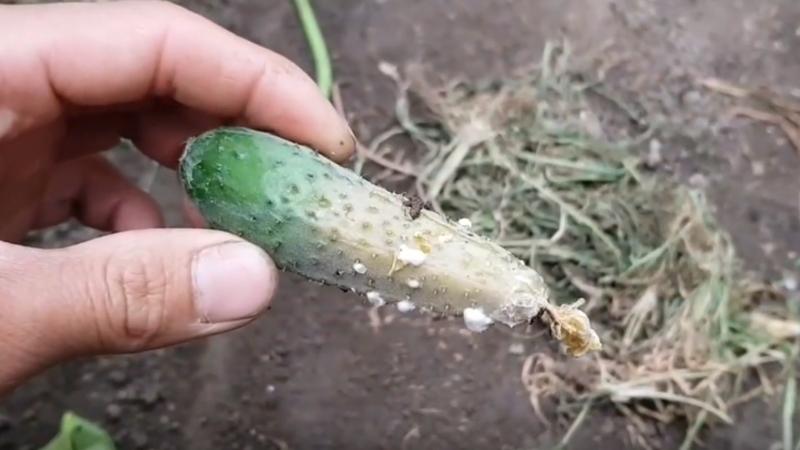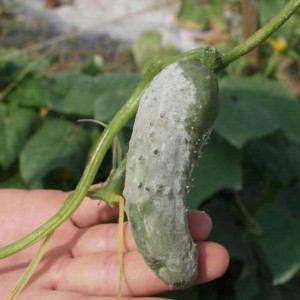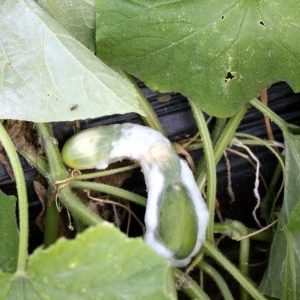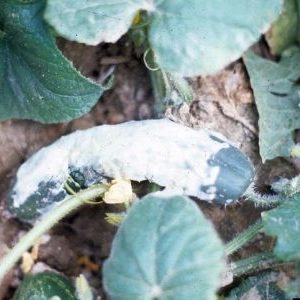How to cure cucumbers in a greenhouse from white rot
White rot is a dangerous disease that affects many crops and leads to complete or partial loss of crops. Getting rid of fungus on cucumbers is not easy. There are many methods, but in order to choose the right one, you need to understand the cause of the development of the disease and approach the problem in a comprehensive manner.
This article is devoted to the question of how to save cucumbers from white rot.
The content of the article
Why do cucumbers start to rot in a greenhouse
For the development of white rot, as a rule, two factors are enough: high humidity and low air temperature. However, other reasons can provoke the onset and development of the disease.
The main reasons for the appearance and spread of rot
The appearance of rot on cucumbers grown in the open field is caused by bad weather conditions: low air temperature, abundant and prolonged rainfall, lack of sun.
In greenhouse conditions, the fungus appears due to:
- poor ventilation or its complete absence;
- temperature changes day and night;
- accumulation of condensate;
- glaze cold water;
- planting non-disinfected seeds.
Also, the appearance and spread of rot can be caused by a violation of the terms and rules of pruning, excessive planting density or the use of dirty and possibly contaminated knives or pruners.

Causative agents of the disease
The causative agent of the disease is the marsupial fungus Sclerotinia sclerotiorum, a parasite that can grow on the body of a plant or in the environment. The spores of the fungus penetrate the tissues of the plant, germinate and form mycelium - a characteristic white bloom resembling cotton wool.
Sclerotinia actively grows and forms fruiting bodies filled with new spores that spread throughout the plot or greenhouse and can affect the entire plantation.
Varieties of rot
The fungus can develop not only on fruits - it depends on the type of rot. So, the following varieties are distinguished:
- White - the result of the vital activity of the fungal parasitic organism. It affects any part of the plant.

- Root affects the root system. It is observed both on newly emerged seedlings and on adult plants.
- Gray most often develops on leaves, but can also affect fruits. The pathogen is resistant to environmental changes, remains viable on plant debris.
- Vershinnaya - a disease provoked by the apical variety of the parasitic fungus. As a rule, it occurs as a result of a violation of the irrigation regime, a lack of calcium or an excess of nitrogen.
Any type of rot leads to damage to the bush and the crop, so it is important to identify the causes in a timely manner and begin to fight the disease.
White rot (sclerotinia): what is it
White rot, or sclerotinia, is an infectious fungal disease, the external manifestation of which depends on the life cycle of the fungus.
So, at the sclerocial stage, the fungus develops on the surface or inside the plant in late summer - early autumn. Forms sclerotia - bodies that, at rest, endure winter in soil or plant debris.
When high humidity is established, and the air temperature rises to + 16 ° C, sclerotia germinate and create fruiting bodies - thin stems with bowls at the ends of 5-15 mm in diameter.They contain many ascospores that enter damaged plants through the air. This is how the development of a fungal infection begins.
Symptoms
White rot has a number of symptoms that make it difficult to confuse it with other diseases:
- the appearance of a large number of wet stains on different parts of the plant;
- wateriness, sweetness of the affected areas;
- the formation of white flocculent plaque on the foci of infection;
- wilting and dying off of leaves and tops of shoots;
- development of black sclerotia on the affected parts, visible on the cut.
The manifestation of external signs depends on the stage of development of the disease.
Propagation paths
The primary source of infection is soil and plant debris in which sclerotia hibernate. On a plot or greenhouse, spores spread through the air, through insects and the hands of a gardener.
The danger
Sclerotinia is an insidious disease. Its main danger is:
- the ability to infect both young seedlings and fruiting bushes, which leads to a drop in yield;
- long life of the fungus in the soil and on the remaining parts of the diseased plant;
- the likelihood of a fungus entering during soil renewal or watering;
- damage to all parts of the plant.
In addition, the fungus can infect not only cucumbers, but also any other crop: its spores spread quickly, which entails the disease of all plants, especially in the greenhouse.
Cucumber treatment methods
How to deal with the disease? Treatment of white rot on cucumbers in a greenhouse is carried out using special chemicals or folk remedies. It depends on the stage of development of the disease and the extent of its spread.
Unfortunately, in an extreme case, when the disease has reached its peak, drastic measures are required - the complete destruction of the infected plant.
With the help of agrochemistry
The use of fungicides is a last resort, requiring caution and personal safety. Processing should be done in the morning or evening. The optimum air temperature for this is + 20 ... + 25 ° C during the day and + 18 ... + 22 ° C at night.
Plants are sprayed from bottom to top at a distance of 15 cm. Do not use fungicides during fruiting and 20 days before it begins.
| Drug name | Quantity per 10 l of water | Treatment |
| "HOM" | 40 g | Twice with an interval of 10-14 days |
| Abiga Peak | 50 ml | Spray the bushes three times, every week |
| "Ordan" | 25 g | Twice spraying at intervals of 10-14 days |
| "Oxyhom" | 30 g | Depending on the degree of damage, the treatment is carried out 1-3 times with an interval of two weeks |
| "Acrobat MC" | 30 g | Twice processing with a difference of 10 days |
| "Topaz" | 1 ampoule | Two treatments - one per week |
10-14 days after the treatment with chemicals, the plants must be sprayed with a 1% solution of biofungicide (Planriz) to increase their immunity.
Disinfection of soil
Sclerotinia are able to maintain vital activity in the soil for more than five years... Therefore, to minimize the risk of re-development of the disease on the site and in the greenhouse after harvesting, the beds, along with plant residues, must be disinfected.
With small volumes of damage, the soil, after removing the remains of diseased plants from it, can be calcined in an oven.
It is also practiced to treat the soil with a solution of copper sulfate (50 g of powder per 10 liters of water) at the rate of 2 liters per 1 sq. m. A day after treatment, it is necessary to burn the waste of plants along with the roots, and re-disinfect the soil or replace it with a new one in spring.
Biological method
A method based on the use of a special fungus that suppresses the activity of sclerotinia. It is used when the use of chemicals for any reason is impossible.
Spores of the fungus are contained in the composition of "Trichodermina", which is suitable for the treatment of both bushes and soil around, which increases the effectiveness of its action. The drug can be used to disinfect rooted plants, seedlings and seeds before sowing.
The drug "Planriz" has the same effect - it fights against white and gray decay of cucumbers. The product can be added to the planting hole when rooting seedlings, soaked seeds in it, or used to spray bushes before flowering.
The indisputable advantage of the preparations is that they are completely harmless to people, the environment and pollinating insects.
With the help of pharmacy and kitchen products
In the early stages of the disease, when only small areas of the greenhouse are affected, you can use simple remedies from the medicine cabinet or from the kitchen shelf. To process plants, you need to prepare a solution by diluting in 10 liters of water of your choice:
- 10 ml of brilliant green;
- 1.5 g of potassium permanganate;
- 1 tbsp. baking soda;
- 10 ml of iodine;
- 200 g baking soda and 1 bar of laundry soap;
- several crystals of potassium permanganate (until a light pink hue appears), 8 tbsp. l. soda and 1 tbsp. l. soap.
In order to avoid burns on plants, it is necessary to strictly control the dosage of pharmaceutical preparations, and carry out the treatment in the evening.
Folk ways
There are several popular ways that help cope with small foci of infection:
- 100 g of compressed yeast dissolved in 10 liters of warm water;
- a mixture of 10 liters of water, 3 liters of milk whey and 1 tsp. copper sulfate;
- solution consisting of 10 liters of water, 1 liter of milk, 1 tbsp. l. shavings of laundry soap and 30 drops of iodine;
- 150 g of garlic cloves infused in 10 liters of water for a day, peeled and passed through a press (you can replace 1 kg of chopped garlic arrows);
- diluted in 10 liters of water 2 g of copper sulfate, 10 g of urea and 40 g of laundry soap.
You can also fight white rot with horsetail. You need to fill a 10-liter enamel bucket with it for a quarter, pour 3 liters of water, put on fire and boil under a lid for half an hour over low heat. After that, the broth should be cooled, filtered and diluted in 10 liters of water.
Important! Folk remedies do not affect the fungus as effectively as chemical preparations, so the treatment should be carried out 2-4 times with a difference of 5-7 days.
How to treat a greenhouse to destroy white rot
Greenhouse processing consists of several stages:
- getting rid of infected plant parts;
- treatment with a solution of copper sulfate of the soil and all surfaces in the greenhouse;
- fumigation of the space with the smoke of a sulfuric bombs and subsequent ventilation;
- careful digging of the earth, sowing white mustard in the winter.
In the spring, two weeks before planting the seedlings in the greenhouse, it is necessary to re-dig the soil and process it with "Baikal EM-1".
Prevention
To prevent the appearance of white rot in the greenhouse, it is recommended:
- thoroughly process and disinfect the soil;
- additionally process the soil before planting seedlings, pouring a solution of potassium permanganate into each hole (5 g per 10 l of water);
- plant cucumbers at a sufficient distance from each other;
- promptly remove and burn plant residues from the beds.
Re-development of the disease will help to avoid:
- air humidity level control;
- regular ventilation of the greenhouse;
- timely removal of decaying stems, fruits and young shoots;
- one-time watering of the bushes with Planriz solution (0.01%) during flowering.
It is also important to follow the rules for watering and top dressing and use only clean tools when pruning bushes.
Conclusion
White rot is a common disease that affects any part of the plant. It is possible to save infected plantings and avoid the spread of infection throughout the entire site only with the timely use of antifungal agents, the choice of which depends on the cause and degree of development of the disease.